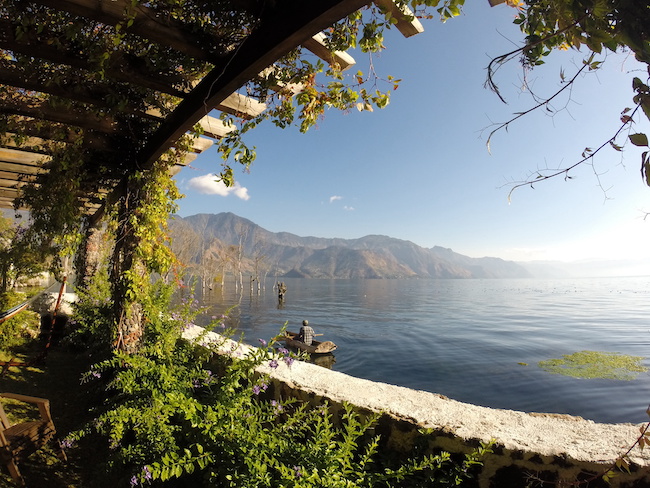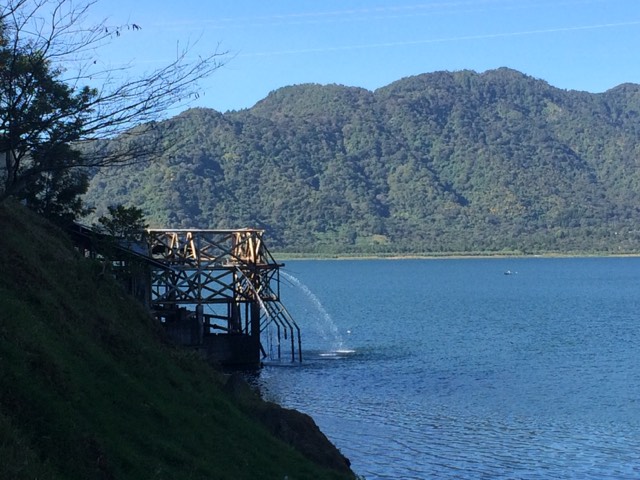
Just one look at Lake Atitlan is enough to fall in love. The lake is 340 meters deep, 18 kilometers long, and approximately 84,000 years old. The waves ripple between the bases of three massive volcanoes, and the colorful local communities only add to the region’s splendor. Upon glimpsing the lake in all its majesty, you’re hardly alone if your first desire is to dive right in.
But when you actually get to the shore, a few sobering observations might dampen your enthusiasm. Perhaps you’ll notice a massive tube with the stinky water flowing directly into the lake. Maybe you’ll see plastic bottles, food containers, and other pieces of trash caught up among the weeds.
Whatever you find, you’re sure to stop and ask yourself a few key questions.
Is it safe to swim in Lake Atitlan?
It’s generally considered safe to swim in Lake Atitlan. Many of the lake’s hotels and resorts boast swimming areas and docks, and some of the towns also have public swimming areas. San Marcos, with its nature reserve and massive diving platform, is an especially popular spot for bathers. Santa Catarina Palopo, meanwhile, has a set of hot springs, perfect for relaxing after a long day. Wherever you decide to take a dip, you shouldn’t have to worry about any adverse effects on your health.

Can I eat the fish from the lake?
The markets and restaurants around Lake Atitlan are full of delicious local fish, and most people think you can eat them without any risk. There are a few different species you’re likely to encounter. “Mojarras” are native to the lake, and they’re the main target for many of the fishermen you’ll see dropping lines from their canoes. While the mojarra population has sadly dwindled in recent years, you can still enjoy one if you’re willing to pay a premium price. Tilapia, raised in captivity along the shores of the lake, provide a cheaper alternative.
So should you eat fish from the lake? The general consensus is yes, you can, but in great moderation. Some have told us that you don’t want to eat fish more than once a month from the lake. Others recommend staying away all together. While still others have told us they’ve been eating fish from the lake all their life and have never had any problems. At the end of the day, the lake is more polluted than we might hope, and this can certainly have an impact on marine life.
Does the tap water come from the lake? Can I drink it? Wash dishes? Brush my teeth?
In many cases, the tap water does indeed come from the lake. Considering the contamination the lake has suffered, you definitely want to stick with bottled water. In general, consuming tap water in Guatemala is a bad idea.
When it comes to washing dishes and brushing teeth, there’s no true consensus. Most visitors use the tap water for these routine tasks without any problems, but others prefer to exercise more caution. Ultimately, the choice depends on your body, your budget for bottled water, and your personal level of risk aversion.
How has the lake become contaminated?
In the past, Lake Atitlan was essentially contaminant-free. The local communities used the lake for their drinking water, and the natural habitat flourished. It was only in the 20th century — with populations growing, tourism increasing, and modern habits taking hold — that the lake began to suffer.
Today, untreated wastewater enters the lake at an alarming rate. Runoff from pesticides and fertilizers also takes a toll. Biodiversity has been decimated by the carnivorous black bass, a non-native species introduced in a misguided attempt to attract foreign anglers. All this has left the lake in a precarious position.

What’s being done to address the issue?
International organizations, Guatemalan interest groups, and local municipalities are all looking for ways to improve Lake Atitlan’s water quality. Most of the efforts focus on the region’s wastewater, only 20% of which is currently treated. Building more wastewater treatment plants to keep raw sewage from entering the lake will give the basin a better chance of undergoing a natural renewal.

What’s in store for one of the world’s most beautiful lakes?
Lake Atitlan, a true gem of the natural world, finds itself in a concerningly vulnerable state. In recent years, cyanobacteria blooms have turned portions of the surface green, putting the extent of the contamination on full display. The local people, whose ancestors have lived in the area for centuries, fear their revered lake could be in serious trouble. Mitigation efforts are costly, and different organizations often disagree on the best way forward.

But there are reasons to be hopeful. The level of public awareness of the issue has never been higher. Lakeside communities recognize the need for forward-thinking solutions, and new ideas for wastewater management seem to spring up every day. Creating a cleaner Lake Atitlan won’t be easy, but there are countless people dedicated to the project. Once smitten with the beauty of the lake, you might become one of them.